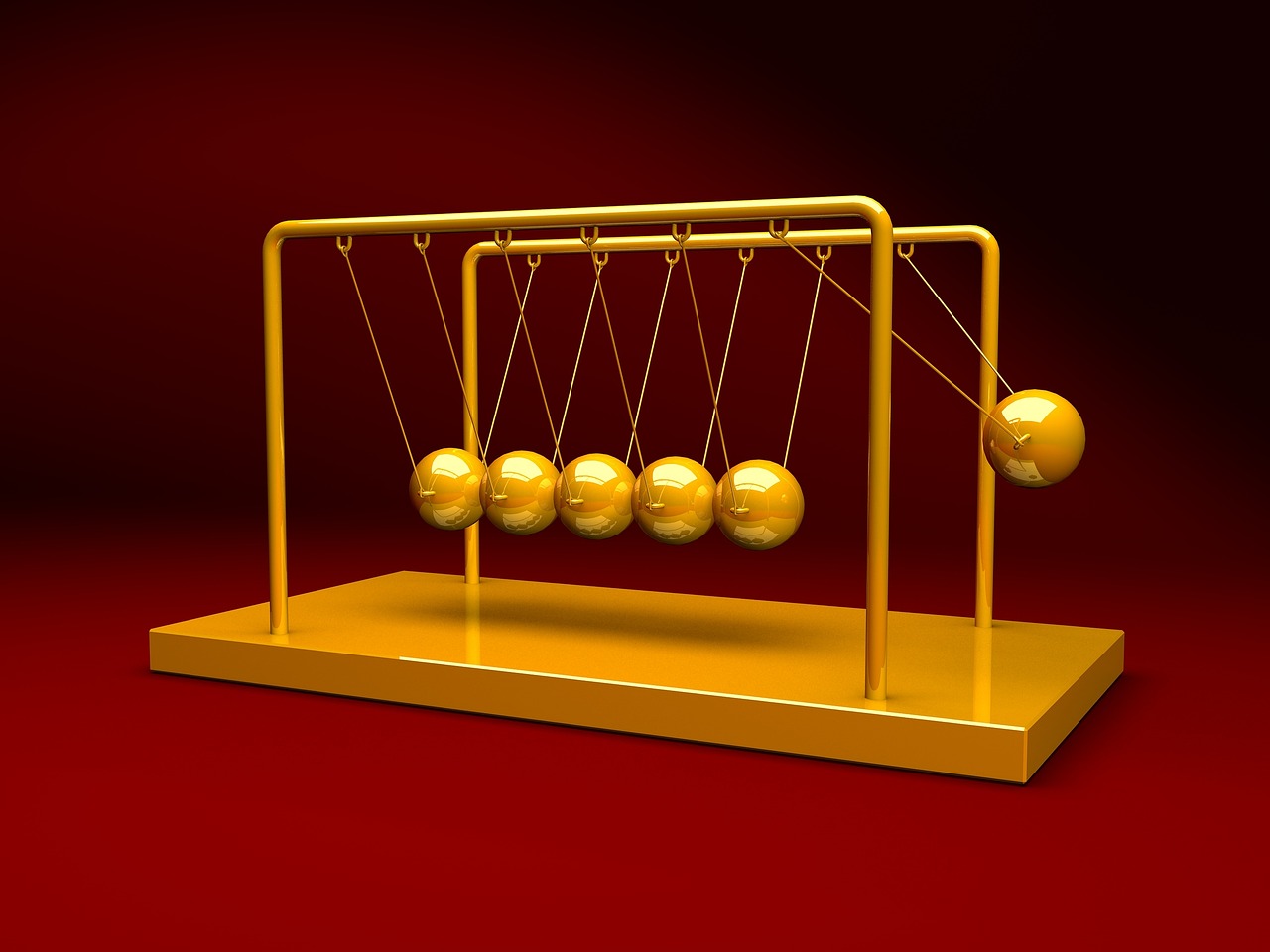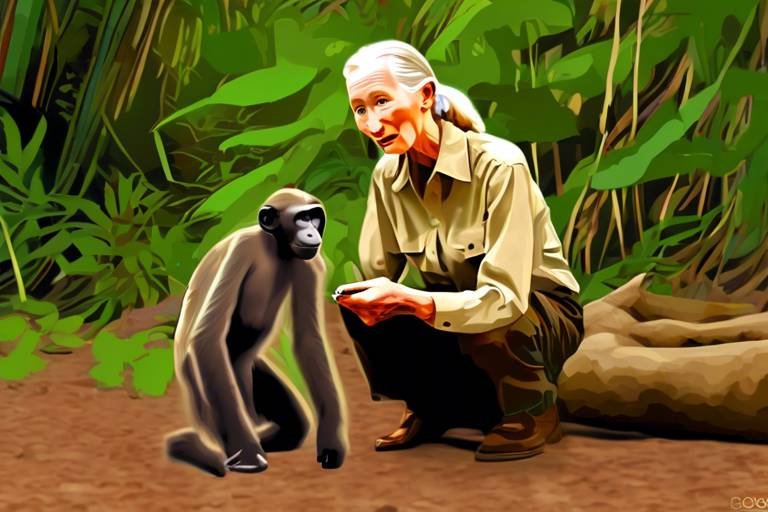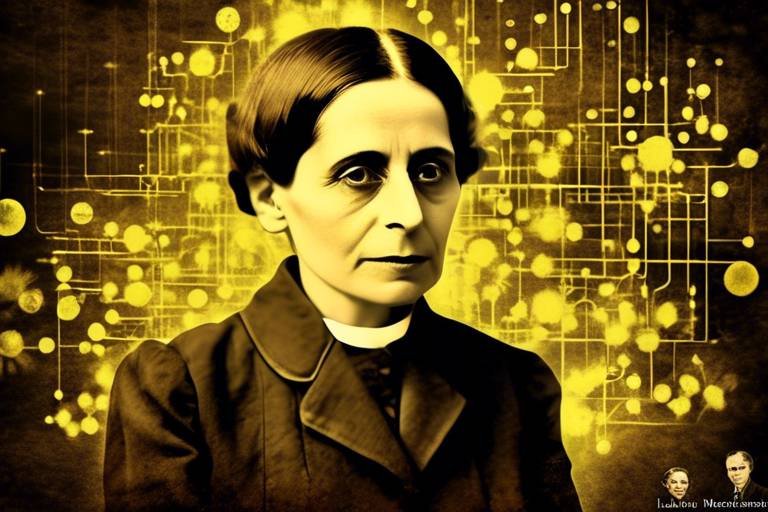The Life of Isaac Newton and Classical Mechanics
Isaac Newton, a name synonymous with scientific revolution, was born on January 4, 1643, in Woolsthorpe, England. His journey from a curious child to a towering figure in the realms of physics and mathematics is nothing short of extraordinary. Newton's life was marked by a relentless pursuit of knowledge, and his contributions laid the groundwork for classical mechanics, a field that continues to shape our understanding of the universe today. But what drove this brilliant mind? What were the pivotal moments that ignited his passion for science? In this article, we will explore the remarkable life of Isaac Newton, his groundbreaking discoveries, and the lasting impact of his work on science and mathematics.
Isaac Newton's formative years were pivotal in shaping his intellectual pursuits. Born to a farmer, he faced challenges early on, especially after his father's death. His mother remarried, leaving him in the care of his grandmother, which fueled a sense of isolation in young Isaac. However, this solitude allowed him to delve into his studies, revealing a keen interest in mathematics and the natural world. He attended the King's School in Grantham, where he was introduced to the works of great thinkers such as Euclid and Descartes.
His education continued at Trinity College, Cambridge, where he was exposed to the burgeoning ideas of the Scientific Revolution. During his time at Cambridge, he developed a profound understanding of mathematics and physics, and it was here that he began to formulate ideas that would later revolutionize these fields. The Great Plague of 1665 forced the university to close, but this turned into a blessing in disguise for Newton. During this period of isolation, he engaged in intense study, leading to some of his most significant discoveries.
Newton's contributions to physics transformed our understanding of motion and gravity. His work laid the foundation for classical mechanics, which describes the motion of objects and the forces acting upon them. Two of his major discoveries include the laws of motion and the law of universal gravitation. These principles not only explained the mechanics of earthly objects but also the movements of celestial bodies, fundamentally changing how humanity perceives the universe.
Newton's three laws of motion are often regarded as the cornerstone of classical mechanics. Each law describes a fundamental principle governing the behavior of objects in motion. Let's break them down:
The first law states that an object at rest stays at rest, and an object in motion continues in motion with the same speed and in the same direction unless acted upon by an external force. This concept of inertia is profound; it implies that motion is a natural state for objects, and only external forces can change that state. Imagine a hockey puck gliding on ice—it will keep sliding until friction or another force brings it to a stop.
The second law establishes the relationship between force, mass, and acceleration, encapsulated in the formula Fma. This principle is essential for analyzing motion in various contexts. For example, if you push a car (which has a large mass), it requires significantly more force to accelerate than if you pushed a bicycle. This law not only describes how objects move but also provides a mathematical framework for predicting their behavior under different forces.
Newton's law of universal gravitation describes the gravitational attraction between masses. He proposed that every mass attracts every other mass in the universe, and the force of this attraction is proportional to the product of their masses and inversely proportional to the square of the distance between them. This law revolutionized the understanding of celestial mechanics and planetary motion, allowing scientists to predict the orbits of planets and understand the forces that govern the universe.
In addition to his work in physics, Newton made significant advancements in mathematics, particularly in calculus. His development of calculus, alongside Gottfried Wilhelm Leibniz, provided essential tools for analyzing change and motion. This branch of mathematics has become indispensable in various scientific fields, enabling complex problem-solving and modeling.
Newton's formulation of calculus was groundbreaking. He introduced the concepts of limits, derivatives, and integrals, which allow scientists and mathematicians to describe and analyze dynamic systems. Calculus serves as the mathematical backbone for physics, engineering, economics, and more. It's the language of change—whether it's the trajectory of a rocket or the growth of a population.
In his seminal work, Philosophiæ Naturalis Principia Mathematica, Newton combined mathematics and physics, establishing a systematic approach to understanding natural phenomena. This work not only outlined his laws of motion and universal gravitation but also set a precedent for future scientific inquiry. It marked the beginning of modern science as we know it, emphasizing observation, experimentation, and mathematical reasoning.
Newton's influence extends beyond his lifetime, shaping modern science and mathematics. His work laid the foundation for classical mechanics, which remained unchallenged until the advent of relativity and quantum mechanics in the 20th century. Scientists like Albert Einstein built upon Newton's principles, demonstrating their limitations while acknowledging their profound impact. Today, Newton's theories continue to be taught in schools and universities worldwide, inspiring new generations of scientists and thinkers.
- What are Isaac Newton's most famous contributions? Newton is best known for his three laws of motion and the law of universal gravitation.
- How did Newton's work influence modern science? His systematic approach to physics and mathematics laid the groundwork for classical mechanics and scientific inquiry.
- What is calculus and why is it important? Calculus is a branch of mathematics that deals with rates of change and motion, essential for various scientific fields.

Early Life and Education
Isaac Newton, one of the most influential figures in the history of science, was born on January 4, 1643, in Woolsthorpe, England. His early life was marked by a series of events that would profoundly shape his intellectual development. Born prematurely and raised by his mother after his father passed away when he was just three, Newton's childhood was anything but ordinary. Imagine a young boy, left to navigate the world without a father figure, yet destined to become a titan of knowledge!
As a child, Newton showed signs of brilliance. He was not particularly interested in the traditional subjects of his time; instead, he was fascinated by the mechanics of the world around him. His curiosity led him to build various devices, including a water clock and a small windmill, showcasing his innate desire to understand how things worked. This inquisitive nature would later become the bedrock of his scientific achievements.
Newton's formal education began at the King's School in Grantham, where he was introduced to the classics and mathematics. However, it was during his time at the University of Cambridge that his intellectual journey truly took off. Enrolling at Cambridge in 1661, he immersed himself in the studies of mathematics, physics, and astronomy. The university was a hotbed of intellectual activity, and it was here that Newton encountered the works of great thinkers like Descartes and Galileo.
In 1665, a significant turning point occurred in Newton's life: the Great Plague forced the university to close. Rather than succumb to despair, he returned to Woolsthorpe and spent the next two years in self-imposed isolation. During this period, often referred to as his "annus mirabilis" or "year of wonders," he developed some of his most groundbreaking ideas. It's fascinating to think that a global pandemic could catalyze such revolutionary thought!
Newton's education was not just limited to formal schooling. He was a voracious reader, often delving into works that spanned various fields. His notebooks from this period reveal a mind racing with ideas, calculations, and sketches. This relentless pursuit of knowledge would later culminate in his monumental works that would change the course of science forever.
To summarize, Newton’s early life and education were characterized by:
- A challenging childhood marked by the absence of his father.
- A natural curiosity that drove him to explore the mechanics of the world.
- A transformative education at Cambridge, where he encountered the works of great philosophers and scientists.
- A period of intense personal study during the Great Plague, leading to revolutionary discoveries.
In essence, Newton's formative years were a blend of personal challenges and intellectual triumphs, setting the stage for the extraordinary contributions he would later make in the fields of physics and mathematics. His journey from a curious boy to a legendary scientist is a testament to the power of perseverance and intellectual curiosity.

Key Discoveries in Physics
Isaac Newton's contributions to physics were nothing short of revolutionary, fundamentally altering our understanding of the universe. His insights into motion and gravity not only laid the groundwork for classical mechanics but also paved the way for countless advancements in science and engineering. Imagine a world where the movements of celestial bodies were shrouded in mystery; Newton's work illuminated this darkness, allowing humanity to grasp the principles governing the cosmos. His discoveries can be categorized into two major areas: the laws of motion and the law of universal gravitation.
Let's dive deeper into these key discoveries and see how they transformed our understanding of the physical world. Newton's three laws of motion are particularly noteworthy. Each law describes a fundamental principle that governs the behavior of objects, whether they are at rest or in motion. These laws are not just theoretical concepts; they have practical applications in everything from engineering to everyday activities.
The first law of motion, often referred to as the law of inertia, states that an object at rest stays at rest, and an object in motion continues in motion with the same speed and in the same direction unless acted upon by an external force. This simple yet profound idea suggests that change in motion is not a natural state for objects. It’s like trying to push a heavy boulder—once it’s at rest, it takes a significant force to get it moving again. The implications of this law are vast, affecting everything from the design of vehicles to the understanding of planetary orbits.
Inertia is a concept we encounter daily, often without realizing it. For example, when a car suddenly stops, passengers lurch forward due to their inertia. This is a direct illustration of Newton's first law in action. It reminds us that objects resist changes to their state of motion, a principle that is foundational in physics.
The second law of motion takes us a step further by establishing a relationship between force, mass, and acceleration, encapsulated in the formula Fma. This equation means that the force acting on an object is equal to the mass of that object multiplied by its acceleration. If you push a shopping cart, the harder you push (increased force), the faster it accelerates. Conversely, if the cart is loaded with heavy items (increased mass), it requires more force to achieve the same acceleration. This principle is essential for analyzing motion in various contexts, from sports to space travel.
Now, let’s talk about Newton’s law of universal gravitation, which describes the attractive force between two masses. This law states that every point mass attracts every other point mass in the universe with a force that is directly proportional to the product of their masses and inversely proportional to the square of the distance between their centers. To put it simply, the bigger the objects and the closer they are, the stronger the gravitational pull between them. This discovery was monumental because it not only explained why objects fall to the ground but also how planets orbit the sun.
Imagine standing on Earth, feeling the pull of gravity. Now picture the moon, a massive body, exerting its own gravitational force, influencing ocean tides. This interplay of forces is a direct result of Newton's insights. The implications of universal gravitation extend beyond Earth, shaping our understanding of celestial mechanics and the motion of planets, moons, and even galaxies.
In summary, Newton’s key discoveries in physics—his laws of motion and the law of universal gravitation—have profoundly shaped our understanding of the physical world. These principles not only explain how objects move on Earth but also govern the movements of celestial bodies across the universe. Newton’s work invites us to ponder: how many other mysteries of the universe await discovery, just as he unveiled the secrets of motion and gravity?

The Laws of Motion
Isaac Newton's three laws of motion are not just a set of rules; they are the bedrock upon which classical mechanics is built. These laws provide a comprehensive framework for understanding how objects behave when forces act upon them. Imagine trying to navigate a ship through a stormy sea without any knowledge of the winds or currents—this is akin to understanding motion without Newton's laws. Each law serves a unique purpose, and together, they explain the intricate dance of forces and motion in our universe.
The first law, often referred to as the law of inertia, states that an object at rest will remain at rest, and an object in motion will continue in motion at a constant velocity unless acted upon by a net external force. This principle is akin to a stubborn toddler refusing to move unless coaxed—objects, too, resist changes to their state of motion. For example, consider a hockey puck gliding on ice; it will slide indefinitely unless friction or another force brings it to a stop. This law emphasizes the concept of inertia, a property that all matter possesses.
Next comes the second law, which establishes a clear relationship between force, mass, and acceleration, encapsulated in the elegant formula Fma. In this equation, F represents force, m is mass, and a is acceleration. This law essentially tells us that the acceleration of an object depends on the net force acting upon it and its mass. Imagine pushing a shopping cart: if you apply a greater force, it accelerates faster. Conversely, if the cart is filled with heavy groceries, it requires more effort to achieve the same acceleration. This law is crucial for understanding everything from car crashes to rocket launches.
Finally, the third law states that for every action, there is an equal and opposite reaction. This is not just a catchy phrase; it's a fundamental truth that governs interactions. When you push against a wall, the wall pushes back with equal force. This principle can be observed in everyday life, such as when you jump off a small boat onto the dock; the boat moves backward as you propel yourself forward. Newton's third law is a reminder that forces are always a two-way street, and understanding this interaction helps us grasp the mechanics of movement more deeply.
To summarize, Newton's laws of motion can be viewed as a triad of principles that govern the behavior of objects under various forces. They lay the groundwork for much of modern physics and engineering, providing essential insights into how we interact with the physical world. Whether it's launching a spacecraft or simply rolling a ball, these laws are at play, guiding us through the complexities of motion.
| Law | Description | Example |
|---|---|---|
| First Law | Inertia: An object remains at rest or in uniform motion unless acted upon by a net external force. | A hockey puck sliding on ice will continue moving until friction slows it down. |
| Second Law | The acceleration of an object is directly proportional to the net force acting on it and inversely proportional to its mass (Fma). | Pushing a heavy shopping cart requires more force to achieve the same acceleration as a lighter one. |
| Third Law | For every action, there is an equal and opposite reaction. | Jumping off a boat causes the boat to move backward as you leap forward. |
- What are Newton's three laws of motion?
Newton's three laws include the law of inertia, the relationship between force and acceleration, and the principle of action and reaction. - How do these laws apply in real life?
They explain everyday phenomena, from driving a car to playing sports, providing a framework for understanding motion. - Why are these laws important in physics?
They form the foundation of classical mechanics, influencing various fields, including engineering and astronomy.

First Law: Inertia
The first law of motion, often referred to as the law of inertia, is one of those concepts that seems deceptively simple yet carries profound implications for our understanding of the universe. In essence, Newton stated that an object at rest will remain at rest, and an object in motion will continue moving at a constant velocity in a straight line unless acted upon by an external force. This principle challenges our everyday experiences and forces us to reconsider how we perceive movement and stability.
Imagine you're sitting in a car that suddenly comes to a stop. Your body lurches forward because, according to the first law, your body wants to maintain its state of motion. It’s as if your body is saying, “Hey, I was moving, and I want to keep doing that!” This is inertia at work, and it explains why seatbelts are crucial for safety. Without them, you would continue to move forward while the car stops, potentially leading to serious injuries.
Inertia is not just a quirky phenomenon; it has significant implications across various fields of study, particularly in physics and engineering. For example, consider the design of roller coasters. Engineers must account for the inertia of riders when designing tracks to ensure that the ride is thrilling yet safe. The forces acting on the riders, due to inertia, dictate how fast the coaster can go and how sharply it can turn.
To illustrate the concept of inertia further, let’s look at some practical examples:
- A soccer ball: When a soccer ball is kicked, it rolls across the field until friction or another force, like a player’s foot or a goalpost, stops it. This demonstrates how an object in motion will continue moving until an external force intervenes.
- A book on a table: A book resting on a table will remain there until someone picks it up or pushes it off. The book's inertia keeps it at rest until acted upon by an external force.
- A satellite in space: Once in orbit, a satellite continues to move in a straight line due to its inertia, unless gravitational forces from Earth or other celestial bodies alter its path.
Understanding inertia is crucial for both theoretical physics and practical applications. It lays the groundwork for analyzing more complex motions and forces, leading to further exploration of Newton's other laws. Inertia not only helps us comprehend the behavior of objects in our daily lives but also extends to the grander scale of celestial bodies, influencing everything from planetary orbits to the motion of galaxies.
- What is inertia? Inertia is the property of matter that causes it to resist changes in its state of motion. Objects at rest stay at rest, and objects in motion stay in motion unless acted upon by an external force.
- How does inertia affect everyday life? Inertia affects many everyday situations, such as driving a car, riding a bike, or even walking. Understanding inertia helps explain why seatbelts are important and how we navigate our environment.
- Can inertia be measured? While inertia itself is not directly measurable, it is related to an object's mass. The greater the mass, the greater the inertia, meaning more force is needed to change its state of motion.

Second Law: Force and Acceleration
Newton's Second Law of Motion is a cornerstone of classical mechanics that connects the dots between force, mass, and acceleration. This law can be succinctly expressed with the equation F ma, where F represents force, m signifies mass, and a denotes acceleration. What does this mean in simpler terms? Well, it tells us that the acceleration of an object is directly proportional to the net force acting upon it and inversely proportional to its mass. In other words, if you push a heavy object, it won't accelerate as quickly as a lighter one. This relationship is not just a theoretical concept; it has practical implications in everyday life.
Imagine trying to push a car versus a bicycle. The car, being much heavier, requires a significantly greater force to achieve the same acceleration as the bicycle. This principle is why athletes train to build strength; the more force they can exert, the faster they can accelerate their bodies, whether they're sprinting down a track or lifting weights.
To delve deeper, let's break down the components of the Second Law:
- Force (F): The external push or pull acting on an object, measured in Newtons.
- Mass (m): The amount of matter in an object, which remains constant regardless of its location, measured in kilograms.
- Acceleration (a): The rate of change of velocity of an object, typically expressed in meters per second squared (m/s²).
The beauty of this law lies in its universal applicability. Whether you're launching a rocket into space or tossing a ball, the principles of force and acceleration are at play. For instance, consider the launch of a space shuttle. The engines generate an immense force to overcome the gravitational pull of the Earth, propelling the shuttle into orbit. As the shuttle ascends, its mass decreases due to fuel consumption, allowing it to accelerate even more rapidly. This interplay between force, mass, and acceleration is what makes Newton's Second Law so powerful and essential for understanding motion.
In summary, Newton's Second Law provides a framework for analyzing the dynamics of motion, allowing scientists and engineers to calculate how objects will behave under various forces. This understanding is crucial not just in physics but also in fields like engineering, aerospace, and even sports science. By mastering the relationship defined by the Second Law, we gain insights into the very fabric of our physical world.
- What is the formula for Newton's Second Law?
The formula is F ma, where F is force, m is mass, and a is acceleration. - How does mass affect acceleration?
According to Newton's Second Law, an increase in mass results in a decrease in acceleration if the force applied remains constant. - Can you give an example of Newton's Second Law in action?
Sure! When you push a shopping cart, the acceleration depends on how hard you push (force) and how much stuff is in the cart (mass).

Universal Gravitation
The concept of is one of Isaac Newton's most significant contributions to science. It describes the force of attraction that exists between any two masses in the universe. Imagine the entire cosmos as a grand stage where every object, from the tiniest pebble to the massive planets, is engaged in a dance of attraction, influenced by a force that Newton so brilliantly articulated. This force is not just limited to Earth; it extends across the vast expanse of space, governing the movements of celestial bodies.
Newton's law of universal gravitation can be summarized in a simple formula: F G * (m1 * m2) / r², where F is the gravitational force between two objects, G is the gravitational constant, m1 and m2 are the masses of the objects, and r is the distance between their centers. This elegant equation encapsulates the idea that the greater the mass of an object, the stronger its gravitational pull, and the farther apart two objects are, the weaker the force of attraction between them becomes. Just like how you might feel a stronger pull toward a friend standing close to you compared to one who is across the room, gravitational force behaves similarly.
Newton's insight into gravity revolutionized our understanding of celestial mechanics. Before him, the movement of planets and moons was largely a mystery, often attributed to supernatural forces. However, Newton's law provided a rational explanation for why planets orbit the sun and moons orbit their respective planets. This understanding not only changed the way we perceive our solar system but also laid the groundwork for future explorations in astronomy and physics.
To illustrate the significance of universal gravitation, consider the following points:
- Predictive Power: Newton's law allows us to predict the movements of planets, moons, and even artificial satellites with remarkable accuracy.
- Foundation for Modern Physics: This law is a cornerstone of classical mechanics, influencing the work of later scientists such as Einstein, who expanded upon these concepts.
- Applications in Technology: Understanding gravitational forces is crucial for various technologies, including satellite communication and space exploration.
In summary, Newton's law of universal gravitation fundamentally altered our understanding of the universe. It transformed how we view the cosmos, providing a coherent framework that connects the movements of celestial bodies with the forces acting upon them. This profound insight not only solidified Newton's place in history but also paved the way for future scientific advancements that continue to shape our understanding of the universe today.
- What is the law of universal gravitation? It states that every mass attracts every other mass with a force that is directly proportional to the product of their masses and inversely proportional to the square of the distance between them.
- How did Newton discover the law of universal gravitation? While sitting under an apple tree, Newton contemplated why the apple fell straight down instead of sideways or even upward, leading to his insights about gravitational force.
- What are some applications of universal gravitation? It is crucial for understanding satellite motion, calculating orbits, and predicting the behavior of celestial bodies.

Mathematical Contributions
Isaac Newton was not just a pioneer in physics; he also made significant advancements in mathematics that have had a lasting impact on the field. His work laid the groundwork for modern calculus, a branch of mathematics that has become essential in various scientific disciplines. Newton, alongside the German mathematician Gottfried Wilhelm Leibniz, independently developed calculus in the late 17th century. This was no small feat; it was a groundbreaking achievement that allowed for the analysis of change and motion in a way that had never been done before.
One of the most important aspects of calculus is its ability to deal with infinitesimals—those incredibly tiny quantities that can change, and yet still be analyzed mathematically. Newton's methods of fluxions, which he called calculus, provided a systematic approach to understanding how quantities change over time. Imagine trying to catch a glimpse of a moving object; calculus gives you the tools to analyze and predict its path, making it a powerful tool for scientists and engineers alike.
In his seminal work, “Mathematical Principles of Natural Philosophy,” Newton not only presented his laws of motion and universal gravitation but also combined these physical concepts with mathematical rigor. This work established a systematic approach to understanding natural phenomena, making it one of the most influential texts in the history of science. By integrating mathematics with physics, Newton set a precedent for future scientists to follow, emphasizing the importance of quantitative analysis in understanding the natural world.
Furthermore, Newton’s contributions to mathematics extended beyond calculus. He also made strides in algebra and geometry, exploring the relationships between different mathematical concepts and their applications. His work on binomial expansion, for example, provided a way to expand expressions that would later be fundamental in algebra. These contributions not only enriched mathematics but also facilitated advancements in physics and engineering.
To summarize, Newton's mathematical contributions can be categorized into several key areas:
- Calculus: Development of the fundamental principles of calculus, including differentiation and integration.
- Algebra: Innovations in algebraic expressions and equations, enhancing mathematical problem-solving.
- Geometry: Exploration of geometric principles that laid the groundwork for future mathematical theories.
Overall, Newton's mathematical contributions were not just a side note to his work in physics; they were integral to the scientific revolution of his time. They provided the tools necessary for future scientists to explore the universe in greater detail. As we delve deeper into the realms of mathematics and physics today, we are continually reminded of how Newton's insights and methodologies have shaped our understanding of the world around us.
- What is calculus, and why is it important? Calculus is a branch of mathematics that deals with rates of change and the accumulation of quantities. It is crucial for understanding motion, growth, and many other natural phenomena.
- Did Newton invent calculus? While Newton is credited with developing calculus independently, he was not the only one. Gottfried Wilhelm Leibniz developed calculus around the same time, leading to a historical debate over who should be credited.
- How did Newton's mathematical contributions influence modern science? Newton's integration of mathematics with physics set the standard for future scientific inquiry, emphasizing the importance of quantitative analysis in understanding natural laws.

Development of Calculus
Imagine trying to measure the curve of a rainbow or the speed of a falling apple. This was the challenge that faced mathematicians before Isaac Newton stepped onto the scene. In the late 17th century, Newton, alongside the German mathematician Gottfried Wilhelm Leibniz, independently developed the foundations of calculus, a powerful mathematical tool that allows us to analyze change and motion in ways that were previously unimaginable. Their work marked a pivotal moment in the history of mathematics, opening doors to new scientific discoveries and technological advancements.
Newton's approach to calculus was deeply intertwined with his studies in physics. He was primarily concerned with understanding how objects move and change over time. To do this, he introduced the concept of limits, which helps mathematicians understand the behavior of functions as they approach specific points. This idea is crucial for defining derivatives, which measure how a quantity changes in response to changes in another quantity. For instance, if you’ve ever wondered how fast a car is accelerating, you’re essentially asking for the derivative of its position with respect to time.
In his seminal work, Mathematical Principles of Natural Philosophy, Newton laid out his ideas with clarity and precision. He used calculus to derive the laws of motion and universal gravitation, demonstrating how mathematical principles could be applied to real-world phenomena. This was revolutionary, as it provided a systematic method for scientists to quantify and predict the behavior of physical systems. The beauty of calculus lies in its versatility; it can be applied across various fields, from physics and engineering to economics and biology.
To illustrate the fundamental concepts of calculus, let's look at some key terms:
| Term | Definition |
|---|---|
| Derivative | A measure of how a function changes as its input changes. It represents the slope of the tangent line to the curve at a given point. |
| Integral | A mathematical tool used to calculate the area under a curve, representing accumulation or total change over an interval. |
| Limit | The value that a function approaches as the input approaches some value. It is foundational for defining derivatives and integrals. |
The introduction of calculus was not without its controversies. The debate over who invented it first—Newton or Leibniz—led to a fierce rivalry between British and continental mathematicians. Despite this, both men contributed significantly to the field, and their notations and methods have endured through the centuries. Newton's notation for derivatives, for example, is still widely used today.
In summary, the development of calculus by Isaac Newton was not just a mathematical breakthrough; it was a transformative moment that reshaped our understanding of the universe. By providing the tools to analyze change and motion, calculus has become an essential component of modern science and engineering. Today, we can apply calculus to everything from predicting the weather to designing complex machinery, proving that Newton's legacy continues to resonate in our everyday lives.

Mathematical Principles of Natural Philosophy
Isaac Newton's work in the realm of mathematics and physics culminated in his groundbreaking book, Philosophiæ Naturalis Principia Mathematica, commonly referred to as the Principia. This seminal text not only laid the groundwork for classical mechanics but also illustrated how mathematics could be applied to understand the natural world. Newton's approach was revolutionary; he systematically combined mathematical principles with physical observations, which was a novel concept at the time.
In the Principia, Newton introduced his mathematical framework, which allowed him to describe the laws of motion and universal gravitation with precision. His use of geometry and calculus to explain physical phenomena was akin to painting a vivid picture of the universe, where every stroke represented a fundamental truth about how objects interact. This integration of mathematics and physics was not just innovative; it changed the way scientists approached the study of nature.
One of the key aspects of Newton's mathematical principles was the concept of quantitative analysis. By employing mathematical equations, he was able to express complex relationships in a clear and concise manner. For instance, his famous equation for gravitational force, F G(m1*m2)/r², encapsulates the gravitational attraction between two masses, where G is the gravitational constant, m1 and m2 are the masses, and r is the distance between their centers. This formula not only exemplifies Newton's analytical prowess but also serves as a foundation for future scientific inquiry.
Furthermore, Newton's mathematical principles emphasized the importance of empirical evidence. He believed that theories should be grounded in observable phenomena, and he meticulously gathered data to support his hypotheses. This scientific rigor established a new standard for future researchers, encouraging them to rely on experimentation and observation rather than speculation.
To illustrate the significance of these mathematical principles, consider the following table that outlines some of the key contributions made by Newton in the Principia:
| Contribution | Description |
|---|---|
| Law of Universal Gravitation | Describes the gravitational attraction between two bodies and how it depends on their masses and distance. |
| Three Laws of Motion | Defines the relationship between the motion of an object and the forces acting on it. |
| Calculus | Developed mathematical tools for analyzing change, essential for physics and engineering. |
In essence, Newton's not only provided a framework for understanding the physical world but also set the stage for future advancements in science and mathematics. His legacy is evident in the way we continue to apply mathematical concepts to solve complex problems across various disciplines. Whether it's in engineering, astronomy, or physics, the principles he established remain relevant and indispensable.
- What is the significance of Newton's Principia?
The Principia is significant because it established the laws of motion and universal gravitation, forming the foundation of classical mechanics.
- How did Newton contribute to calculus?
Newton, alongside Leibniz, developed calculus, providing tools for analyzing change and motion, which are crucial for various scientific fields.
- What are the three laws of motion?
The three laws of motion describe the relationship between the motion of an object and the forces acting on it, laying the groundwork for classical mechanics.

Legacy and Influence
Isaac Newton's legacy is nothing short of monumental. His work laid the groundwork for modern physics and mathematics, influencing countless scientists and thinkers throughout history. It's fascinating to think about how one man's curiosity and determination could alter the course of human understanding in such profound ways. Newton's theories are not just relics of the past; they are the very fabric of scientific inquiry today.
One of the most significant aspects of Newton's legacy is his method of scientific inquiry. He emphasized the importance of observation and experimentation, which became the cornerstone of the scientific method. This approach encouraged future generations to question, test, and refine their understanding of the natural world. Imagine a world where inquiry is stifled—Newton's influence ensured that the flame of curiosity would continue to burn brightly.
Moreover, Newton's contributions to mathematics, particularly his work in calculus, paved the way for advancements in various fields, including physics, engineering, and economics. The tools he developed allow scientists to model complex systems and predict outcomes, making it easier to solve real-world problems. Without calculus, the very fabric of modern science would be frayed, and our understanding of the universe would be significantly limited.
Newton's impact can be seen in numerous fields, from astronomy to engineering. For instance, his law of universal gravitation not only helped us understand how planets move but also laid the groundwork for space exploration. The trajectories of spacecraft, the orbits of satellites, and even the paths of comets are all calculated using principles derived from Newton's work. It's almost poetic to think how his insights have propelled humanity into the cosmos.
To encapsulate Newton's influence, consider the following table that highlights some of the key areas where his work has had a lasting impact:
| Field | Impact |
|---|---|
| Physics | Foundation of classical mechanics; understanding of motion and forces. |
| Astronomy | Understanding celestial mechanics; predicting planetary motion. |
| Engineering | Principles of motion applied in design and construction projects. |
| Mathematics | Development of calculus; tools for analyzing change and motion. |
Even in the realm of philosophy, Newton's ideas sparked debates about the nature of reality and our understanding of the universe. His work prompted thinkers like Immanuel Kant to explore the relationship between science and metaphysics, illustrating how deeply interconnected these fields can be. Newton’s legacy is a tapestry woven into the very essence of our quest for knowledge.
As we reflect on Newton's influence, it’s clear that his work is not just a chapter in a history book; it is a living legacy that continues to inspire scientists, mathematicians, and curious minds around the world. His story is a testament to the power of inquiry and the relentless pursuit of understanding. In a way, we are all students of Newton, standing on the shoulders of a giant, looking out into the vast expanse of knowledge yet to be discovered.
- What are Isaac Newton's most significant contributions? Newton is best known for his laws of motion, law of universal gravitation, and advancements in calculus.
- How did Newton influence modern science? His emphasis on observation and experimentation laid the foundation for the scientific method, influencing generations of scientists.
- What is the significance of calculus in today’s world? Calculus is essential for understanding change and motion, impacting fields like physics, engineering, and economics.
- In what ways did Newton's work affect astronomy? Newton's laws helped explain planetary motion and laid the groundwork for space exploration and satellite technology.
Frequently Asked Questions
- What were Isaac Newton's major contributions to classical mechanics?
Isaac Newton made groundbreaking contributions to classical mechanics, notably his three laws of motion and the law of universal gravitation. These principles laid the foundation for understanding how objects move and interact with one another, revolutionizing the field of physics.
- How did Newton's early life influence his work?
Newton's early life was filled with challenges and curiosity. Growing up in a rural setting, he developed a keen interest in mathematics and the natural world. His education at Cambridge further fueled his passion, allowing him to explore complex ideas that would later shape his revolutionary theories.
- What is the significance of Newton's laws of motion?
Newton's laws of motion are fundamental to understanding how forces affect the movement of objects. The first law introduces the concept of inertia, while the second law establishes the relationship between force, mass, and acceleration. Together, they provide a framework for analyzing motion in everyday life and in the cosmos.
- Can you explain Newton's law of universal gravitation?
Newton's law of universal gravitation states that every mass attracts every other mass with a force that is proportional to the product of their masses and inversely proportional to the square of the distance between them. This law not only explained why objects fall to the ground but also described the motion of planets in our solar system.
- What role did calculus play in Newton's work?
Calculus, developed by Newton (alongside Leibniz), was crucial for analyzing change and motion. It provided the mathematical tools necessary for expressing the laws of motion and understanding dynamic systems, making it an essential part of Newton's contributions to both physics and mathematics.
- How has Newton's work influenced modern science?
Newton's work has had a profound and lasting impact on modern science. His theories laid the groundwork for classical mechanics, which is still taught today. Furthermore, his methods of mathematical analysis have influenced countless fields, from physics to engineering, making him a pivotal figure in the history of science.
- What is the legacy of Isaac Newton?
Isaac Newton's legacy is immense. He is often regarded as one of the most influential scientists in history. His discoveries not only advanced the fields of physics and mathematics but also inspired future generations of scientists, leading to advancements in technology and our understanding of the universe.



















